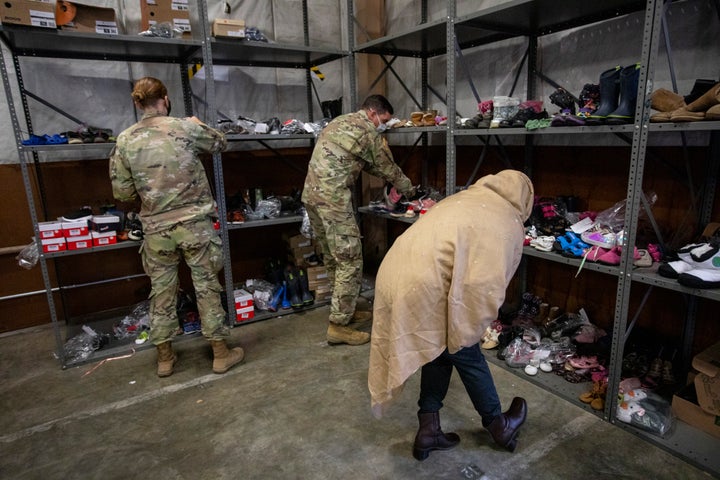
Afghan refugees who have been relocated to military bases in the United States say they don’t have supplies for the upcoming winter and don’t know how much longer they will have to wait for permanent homes.
The largest Afghan evacuee population in the U.S. is in Fort McCoy, Wisconsin, a sprawling base that currently houses 13,000 refugees. Several refugees there told HuffPost that they don’t have winter clothes such as jackets or gloves, even as temperatures have steadily dropped. Some said they have been on the base for months, and they have no clarity about when they’ll be able to leave.
The conditions at Fort McCoy are just one example of what critics say is the Biden administration’s lack of preparedness when it comes to Afghan refugees. Approximately 70,000 Afghans have come to the U.S. since Aug. 17, in an evacuation that was chaotic and incomplete. Tens of thousands of Afghan nationals who had worked with the U.S. were left behind.
About 50,000 evacuees remain in immigration limbo on military bases, and the Pentagon said 44% of the Afghan refugees at U.S. bases were children as of October.
Volunteer and refugee resettlement groups say they are overwhelmed and understaffed, and that the government seems to lack a strategy to transition these individuals to life in the United States.
“There was never a plan because it was so chaotic from the beginning, and there are so many unknowns,” said Spojmie Ahmady Nasiri, a California-based immigration attorney who has visited five of the eight bases where Afghans are currently being housed. “You’re trying to put out the fires as you’re going along and in the process, many people are suffering.”
Limited Access To Warm Clothing And Medical Care
More Afghans are expected to arrive at Fort McCoy, an active military base 105 miles northwest of Madison, within the next few months. The base also houses 1,600 members of the military and 900 contractors who are helping serve meals and provide security, policing and medical care.
One 25-year-old Afghan university student said she arrived at Fort McCoy in September after leaving her family behind in Afghanistan. She said she only had the clothes she was wearing and wasn’t given new ones for more than a month. When she was able to get new clean clothing in October, her options were limited to T-shirts and shorts ― even as temperatures plunged in Wisconsin.
HuffPost spoke to three Afghan women who said accessing the clothing provided by Team Rubicon ― a nongovernment organization specializing in disaster response that the Department of Defense tasked with clothing collection — was chaotic and disorganized. All three women asked to remain anonymous because they feared retaliation for speaking out.

The women said they were told they had less than 20 minutes to sift through bins of clothing, shoes and other essentials and could keep only a limited number of items. The lack of time caused panic, and refugees said they grabbed whatever they could. People pushed and shoved each other in fear they would miss out on the winter clothes. They said many went home with clothes and shoes that didn’t fit or weren’t appropriate for the season.
“It really was a problem,” said the 25-year-old, who ended up giving away most of her clothes to other women because they didn’t fit. “It’s getting colder. We didn’t have this cold back home in Afghanistan. ... We didn’t get any winter jackets. The shoes that we got didn’t fit us because we were in a rush. It’s the same with other girls.”
A second Afghan woman said she went to the distribution center twice in October but wasn’t able to get warm clothing. When she fell ill one day and was suffering from stomach pains, she said she had to wait several hours in a long line before seeing a doctor.
When she complained to the military staff, she said some members responded aggressively.
“I felt like I was a beggar,” she said.
A third woman told HuffPost she resorted to seeking outside help because of the difficulties obtaining warm clothes. An aunt who lives in Canada began mailing her clothes instead.
“We haven’t really seen a coordinated plan from the administration on how to get Afghan allies and other vulnerable Afghans out of Afghanistan and into the U.S.”
- Sunil Varghese, policy director at IRAP
John Stuhlmacher, the senior associate of operations at Team Rubicon, told HuffPost in a statement that the organization was working closely “to meet immediate needs that arise for the Afghan families on the bases.” He said Team Rubicon reaches out to the local community to collect, sort and deliver the donated goods to the base.
“Team Rubicon was asked to collect winter coats for the families on the base and received a second request for additional size-specific needs. The community stepped up and has met the latest requests,” Stuhlmacher said.
A Department of Homeland Security spokesperson told HuffPost that the task force in charge of the distribution “has successfully provided an appropriately sized coat to every Afghan evacuee on base.”
There have also been 22 confirmed measles cases at the base, which put refugees at risk. The DHS spokesperson said there have not been any active cases since early October and that “more than 70,000 Afghan evacuees received age-appropriate vaccinations, including Measles, Mumps, and Rubella as a condition of their humanitarian parole.”
But the refugees on the base say access to halal food, culturally sensitive clothing, and proper medical and dental care is still a problem.
Chaos From Evacuation To Resettlement
Some bases have been better equipped to handle the influx of refugees than others, advocates say. But there are some consistent issues, primarily due to the hasty and disorganized evacuation process.
“These individuals have endured extraordinary difficulties from the minute they tried to get into the airport to get into the lilypads to get into the havens,” Nasiri said. “There’s a lot of trauma. There’s a lot of distrust and a lot of uncertainties.”
The International Refugee Assistance Project, InterAction and Human Rights First released a report on Wednesday that recommended ways the Biden administration could provide more pathways out of Afghanistan and other countries where refugees have landed, as well as how to get them resettled in the U.S. more expediently. Tens of thousands of Afghans who qualified for evacuation are still awaiting next steps, a number advocates said is likely an undercount because many vulnerable groups are still waiting to apply.
They say President Joe Biden’s administration could establish a screening process for at-risk Afghans in a third country, accept alternate methods of identity verification for those who fled without their documents, and increase resources to allow for faster consular and refugee processing.
“We haven’t really seen a coordinated plan from the administration on how to get Afghan allies and other vulnerable Afghans out of Afghanistan and into the U.S., especially those who are eligible for humanitarian pathways in the U.S.,” said Sunil Varghese, the policy director at IRAP.
The White House has defended its withdrawal process from Afghanistan.

Even after Afghans arrive in the U.S., the uncertainty continues.
Last month, the Biden administration announced a new program that would allow groups of private citizens to sponsor Afghan refugees and assist with basic services during their first 90 days in the country, a task that resettlement groups have traditionally led. Refugee agencies have applauded the move, particularly as organizations are overwhelmed and still rebuilding after years of budget cuts under President Donald Trump.
“Unfortunately, the previous administration and dismantling of the program has really left resume agencies in sort of a bare-bones structure mode, a lot of us are functioning with less staff,” said Stacey Clack, the director of community sponsorship and engagement at Church World Service, a faith-based resettlement agency.
More than 22,000 Afghan nationals, American citizens, and lawful permanent residents of the U.S. who were evacuated have since been moved off-base and into long-term housing, according to DHS. Of those, resettlement agencies placed 16,500. Still, about 50,000 evacuees still remain on U.S. bases across the country.
“It’s been somewhat alarming to some of us how quickly we’ve been asked to scale up the program because we’re really concerned about client safeguarding,” Clack said. “We want to ensure our Afghan friends and allies that are coming, whether they’re families or individuals, have the proper support when they leave the bases and enter into communities”
The refugees who are still on bases say they have no clear timeline for when they’ll be able to leave. Families separated during the evacuation also don’t know when or how they will be reunited.
The pandemic and a national shortage of affordable housing have also exacerbated these problems. The immigration system was barely keeping up before an influx of new refugees, advocates say.
“The Department of State as well as the resettlement agencies are actively working to expand housing capacity, as possible, and are connected to a wide range of national and local resources,” a department spokesperson said. “Capacity does exist in many communities around the country that do offer reasonable and available housing as well as strong services and, to the extent possible, individuals will be resettled in these areas. In general, temporary lodging is necessary for a period of time.”
IRAP and immigration lawyers told HuffPost that they worry refugees may fall into bureaucratic limbo.
Afghan nationals who enter the U.S. on parole might have to wait years to receive asylum status. There are currently more than 350,000 pending asylum cases, some of them dating back several years.
Even those eligible for permanent status through the refugee or special immigrant visa, or SIV, process, could also take years, as that program has nearly 18,000 backlogged applicants.
DHS announced earlier this week that it would waive immigration-related fees for up to 70,000 Afghans as they resettled in the U.S. Advocates applauded the move but called on the administration to do more — including introducing the Afghan Adjustment Act, a bill that would give Afghans a roadmap to expeditiously become legal permanent residents.
In the meantime, lawyers and resettlement agencies have relied heavily on grassroots and communal support to fill in the gaps left by government officials. It has also forced resettlement groups to think creatively about solutions to streamline the increased interest from people who want to chip in and help.
“It really is bringing people together faith communities are stepping up. Rotary Clubs are stepping up,” Clack said. “Groups like book clubs and yoga clubs. Community members from all different ends are really stepping up to say, we want to be part of this welcome.”
